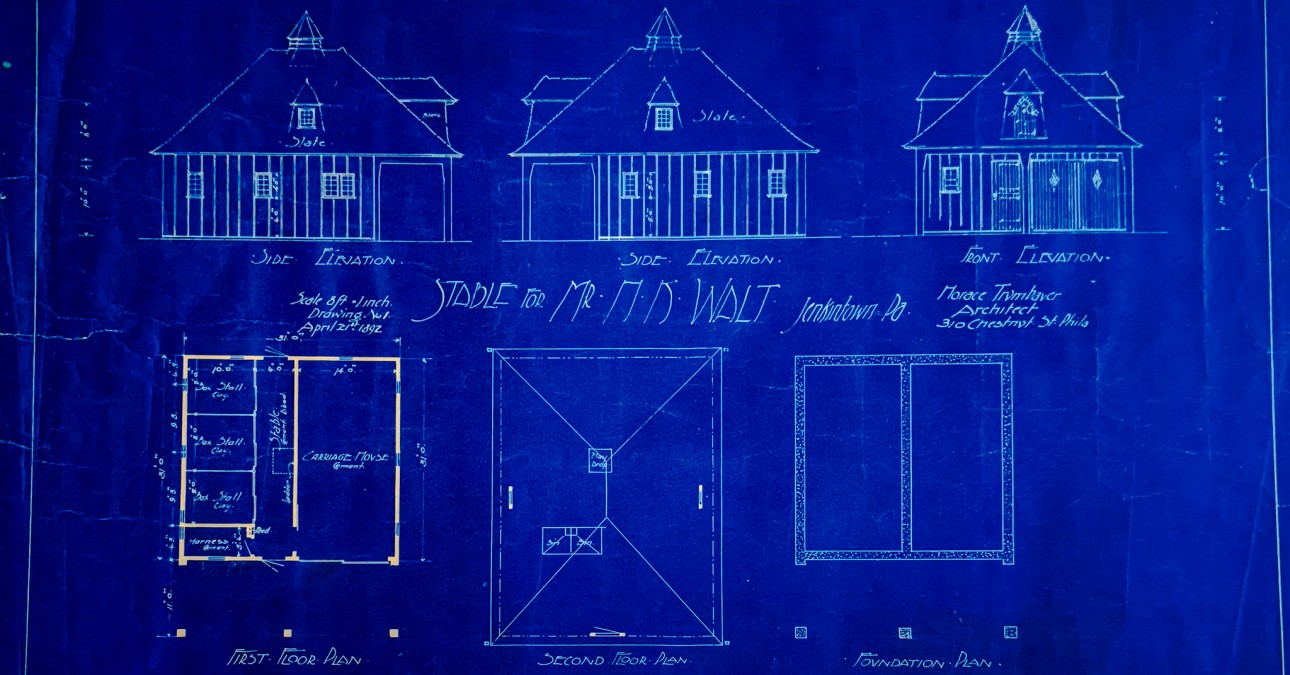
Preserving Architectural Legacy: The Trumbauer Blueprints & Contracts
At CCAHA, we know preservation is rarely a one-off event. It’s a process—often unfolding over years—fueled by passion, stewardship, and collaboration. One recent project exemplifies this kind of long-term commitment: the ongoing conservation of materials connected to Gilded Age architect Horace Trumbauer (1868–1938).
A Remarkable Discovery
This partnership began in 1996 with an extraordinary find. Albert and Daria Kachmar had just purchased Bend Terrace, a historic home in Wyncote, PA, when they received an unassuming trash bag from a descendant of the original owner. Inside this unconventional storage container was a treasure trove of materials related to the Bend Terrace estate, including original architectural blueprints by Horace Trumbauer, property deeds, and other documents dating to the early 20th century.
The home itself was significant: designed by Trumbauer in 1892 for Henry Kline “H.K.” Walt, a Philadelphia businessman and founder of the Jenkintown Trust Company. Recognizing the value of what they had found, the Kachmars brought the materials to CCAHA for professional conservation, initiating what would become a decades-long effort to preserve both the architect’s legacy and the history of the estate.
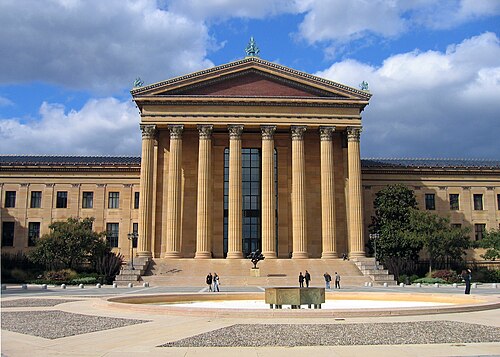
The Architect Behind the Legacy
Horace Trumbauer rose to prominence during the American Gilded Age, known for his opulent residential designs and landmark civic architecture. In 1890, at just 21 years old, he opened his own architectural office in Philadelphia, working independently to establish his reputation. Two years later, at age 23, he designed Bend Terrace, one of his earliest major commissions completed on his own while leading his fledgling practice.
Over the following decades, Trumbauer’s office grew into one of the most prolific architectural firms in the country, producing more than 800 designs that helped shape the American landscape. Among the office’s most iconic projects are the Free Library of Philadelphia’s Parkway Central Branch, the Philadelphia Museum of Art, and Harvard University’s Widener Library. A pivotal figure in this legacy was Julian Abele, who joined the office in 1906 and later became its chief designer. One of the first professionally trained Black architects in the United States, Abele played a leading role in many of the office’s celebrated works, though his contributions went largely unrecognized during his lifetime.
The architectural drawings that survive from Trumbauer’s early office offer rare insight into the aesthetics, construction practices, and grand ambitions of the Gilded Age—while also prompting reflection on the many hands and histories behind these enduring designs.
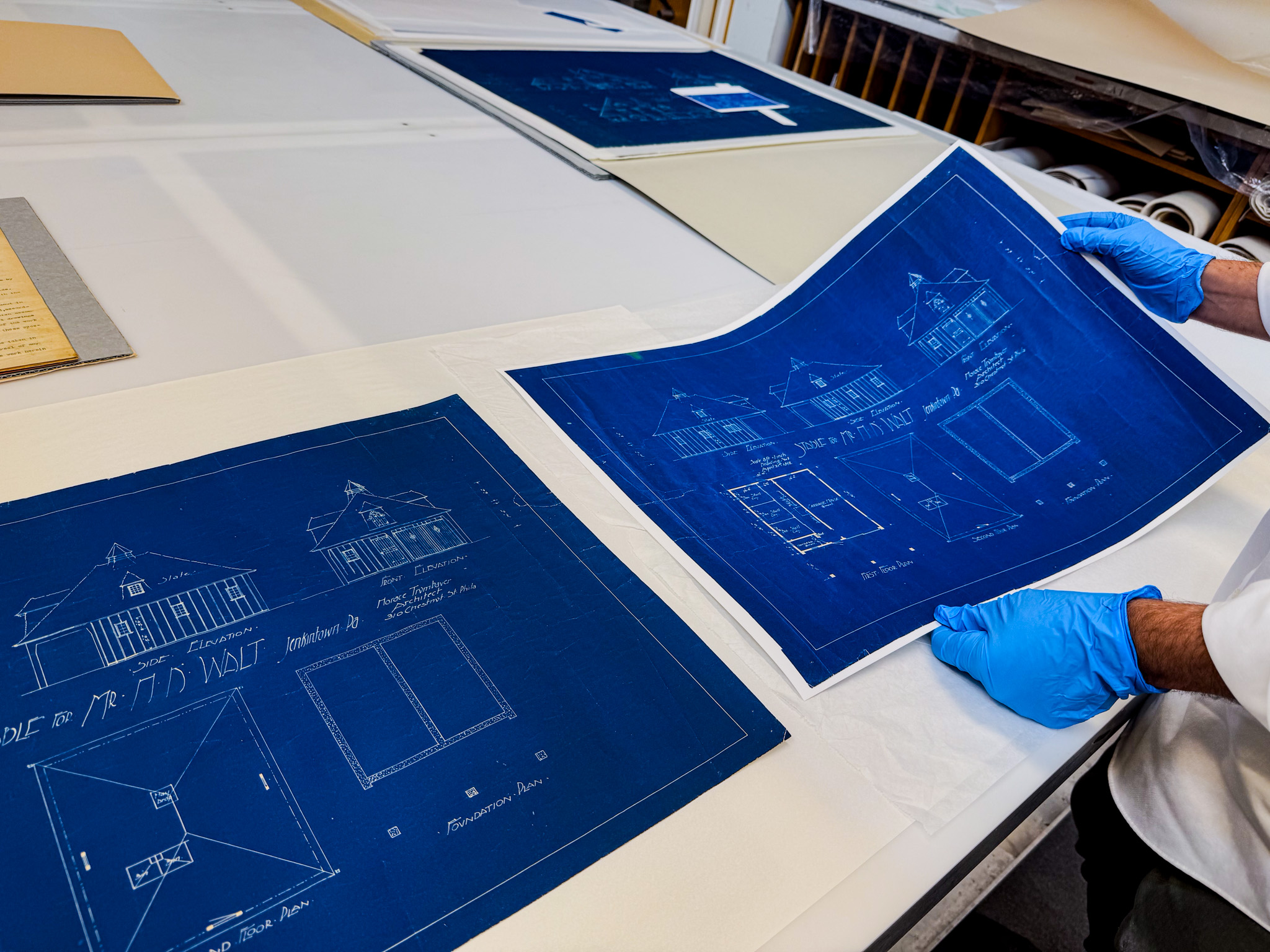
From Blueprints to Deeds: A Continuing Preservation Effort
In the initial phase of conservation in 1996, CCAHA’s primary focus was stabilizing four original Trumbauer blueprints and an early 20th century contract. The blueprints, striking architectural drawings, were created using a light-sensitive chemical process that produced white lines on blue backgrounds, a durable and cost-effective reproduction method widely used from the mid-19th century through the early 20th century.
Nearly 30 years later, in 2025, the Kachmars returned with the goal of producing large-scale facsimiles of those blueprints to ensure long-term preservation and access. This second phase of conservation expanded the project to include a second early 20th century contract.
While the architectural drawings provide a glimpse into Trumbauer’s technical skill, the legal documents add critical historical context—revealing who commissioned the buildings, when they were constructed, and under what terms. Taken together, these materials tell a layered story of architecture, land use, and family legacy in Pennsylvania.
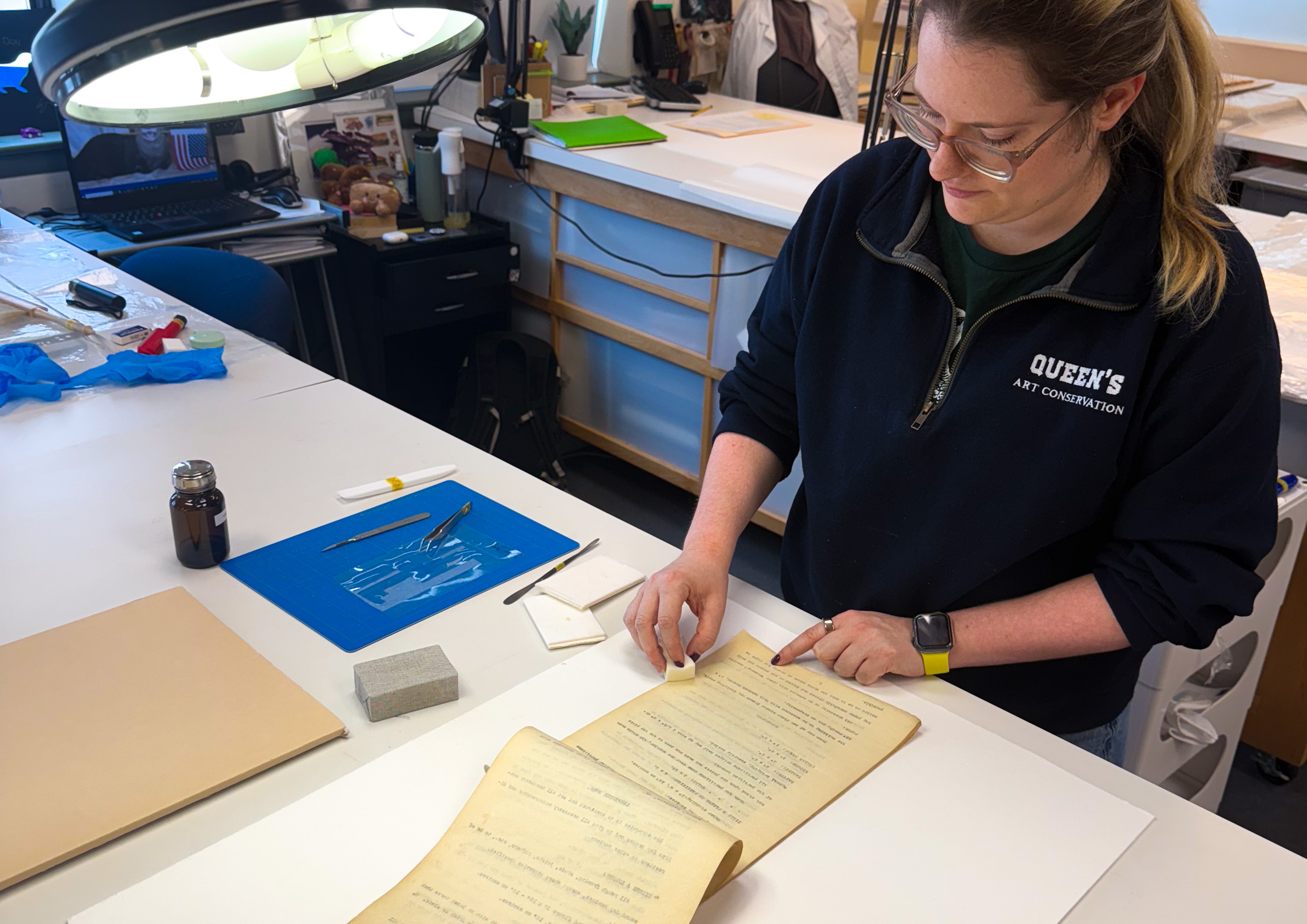
Conservation Challenges and Treatment Approach
The documents treated in 2025 presented new conservation challenges. Some were written in iron gall ink on heavy paper stock—materials valued in their time for their durability but now known to degrade with age, becoming brittle and acidic.
Treatment was led by Sandrine Blais, NEA Conservation Fellow at CCAHA. To stabilize the documents, Blais first performed surface cleaning using soft brushes and cosmetic sponges to gently lift embedded grime. Cracked ink lines were reinforced with thin mulberry tissue and conservation adhesive reactivated with ethanol, allowing for treatment without introducing moisture. Tears and losses were repaired with toned mulberry paper using a combination of wheat starch paste, methylcellulose, and Klucel G. Larger areas of loss were filled with paper toned with acrylics to match the originals. Creased or distorted areas were locally humidified and flattened, restoring the documents to a stable plane.
The approach prioritized stabilization while preserving both the visual integrity and historical character of each item.
Stewardship Beyond the Page
For the Kachmars, this work represents more than document preservation—it’s about honoring a place and its story. In 2024, they founded The Friends of Robinson Park, a nonprofit dedicated to preserving and interpreting the public parkland that once served as the formal gardens of the original 10-acre estate surrounding Bend Terrace.
Their commitment reflects a deep understanding of stewardship that connects architectural history, landscape preservation, and community engagement. As Daria shared, "When we received a Hefty trash bag shortly after we made settlement on the property in 1996, we were stunned by the contents. Since then, we've remained devoted to ensuring the materials are preserved and their story is responsibly shared."
She added that the bag had been tucked away in the rafters of an attic—an improvised method that, while far from conventional for archive storage, kept the contents remarkably dry and intact.
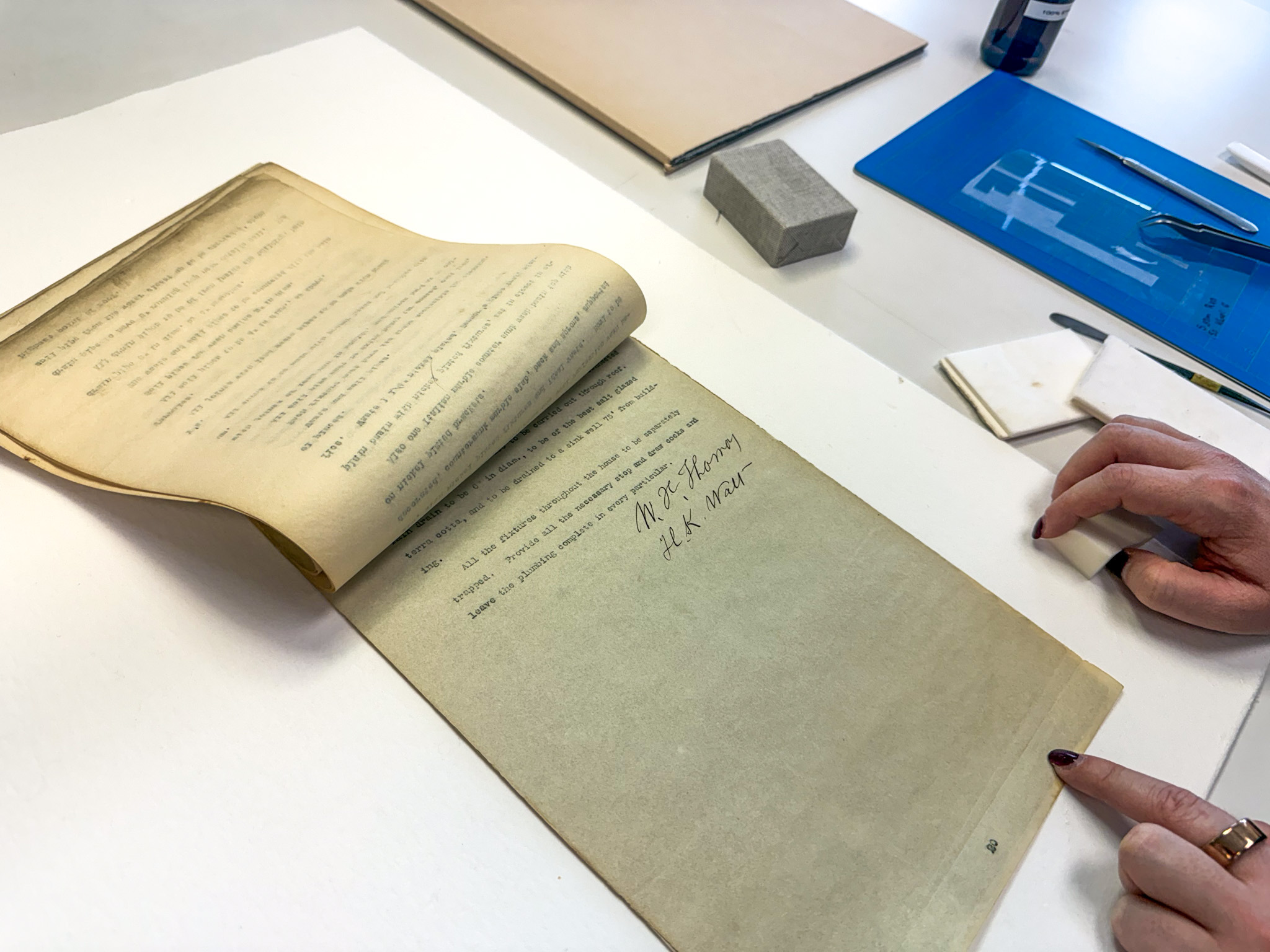
The Value of Long-Term Partnerships
This multi-decade collaboration exemplifies the value of sustained preservation partnerships. Because CCAHA had worked on the initial phase of treatment, our conservators approached this new chapter with deep context and continuity.
“Working with returning clients allows us to understand how individual projects contribute to larger preservation goals,” says one of CCAHA’s senior conservators. “In this case, we’re not just stabilizing documents—we’re helping steward a story that’s still unfolding.”
Learn More: To discover more about Albert and Daria Kachmar's ongoing preservation efforts, visit friendsofrobinsonpark.org.
Images: Detail, blueprint for Bend Terrace stable; Philadelphia Museum of Art (1916–28), a collaboration between Trumbauer's firm and Zantzinger, Borie and Medary; CCAHA Photographer Andrew Pinkham displays a large-scale facsimile alongside an original blueprint of the Bend Terrace stable; CCAHA’s Sandrine Blais removes surface grime from a contract corresponding to the same site using cosmetic sponges and soft brushes; the contract’s signature page.